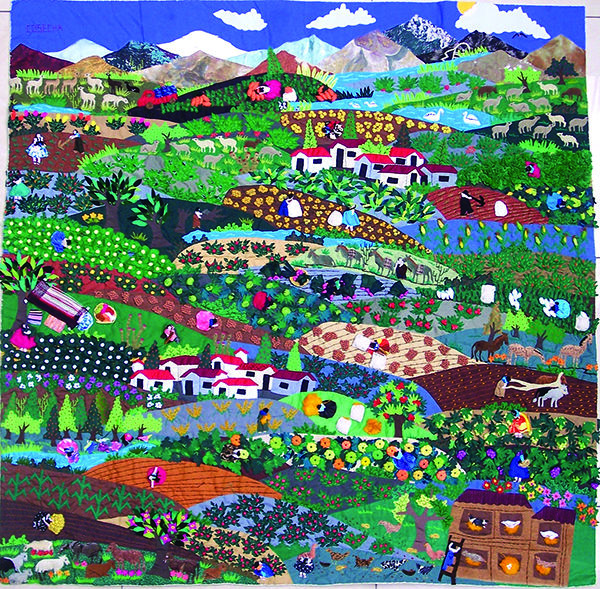You notice the colors first. Reds, greens, blues, yellows — they spring up at you at once, all of them demanding your attention, all of them deserving it.
Then you see the details: a small town with red-roofed houses, a farmer tending to his tilled fields, a river running through a grove of trees, and a dozen more tiny snapshots of rural life. It is all rendered with tremendous intricacy, with an almost living, breathing texture. It is a still-life of paradise.
This particular paradise is stitched together from diminutive individual pieces of fabric, forming a piece of art called a “cuadro” — part embroidery, part quilt, part jigsaw puzzle. The cuadro described above, “Cosecha” (Harvest), is just one of many crafted by the women of Pamplona Alta, a barrio just outside Lima, Peru.
From March 10 to June 27, “Cosecha” and close to 40 other original cuadros will be on display as part of a traveling exhibit entitled “Picturing Paradise: Cuadros from the Peruvian Women of Pamplona Alta as Visions of Hope,” at the William H. Hannon Library at Loyola Marymount University.
“How do you picture paradise?” was the question given to these women, who worked together to fashion these ornate pieces of art. Professor Cecilia Gonzalez-Andrieu, who teaches theology at LMU and helped to organize the exhibit, believes that communal production enhances the theological depth of the cuadros.
“Part of the beauty of” the cuadros, says Gonzalez-Andrieu, “is precisely that they are an expression of a group of women who create together.” These gorgeous images of paradise, then, intertwining the human, the natural and the divine, are syntheses of individual imaginations, individual visions as they become a shared dream.
The full power of these imaginations and extent of these visions is only fully understandable after seeing the home of the artists, Pamplona Alta. If the first thing you notice about the cuadros is the color, then the absence of it is the most striking thing about Pamplona Alta. Mountains loom overhead, imposing and threatening, and barren roads wind up and around them like rivers of dust. Even from a photograph you can almost hear the soil wheezing with thirst. There is not a ghost of the vibrancy that electrifies the cuadros.
When called upon to create their own pictures of paradise, then, these women, these artists, had only themselves and their faith to examine for inspiration. Adamant in their refusal to accept a pale, pallid world, they took visions of color and abundance from their own souls and poured them into their artwork.
“Everything beautiful in the world,” says Gonzalez-Andrieu, “has the source of that Beauty in God.” Every one of these cuadros, she adds, stands as “a small window into God's reality.”
Perhaps, then, when God gazes upon places like Pamplona Alta, God sees a cuadro. God sees communities of love, talent, and faith, bursting from the seemingly infertile dust. God sees artists treating their bleached town like a canvas on which they can stitch the reds, greens, blues and yellows of their lives, of their struggles, of their dreams, of their visions of paradise.
Perhaps, when God gazes upon places like Pamplona Alta, God notices our colors first.
Emmett Schlenz is a sophomore English and History double major at Loyola Marymount University.
‘Picturing Paradise’
“Picturing Paradise/Destellos del Paraiso” is on display at the William H. Hannon Library at Loyola Marymount University from March 10 through June 27.
Additionally, LMU is hosting an opening program and reception with the curator on March 13, and a Spanish-language program and fiesta on March 16. Admission to both programs and the exhibition is free and open to the public.
To RSVP for the March 13 or 16 programs, or for hours, directions and parking, call (310) 338-4235, or visit libguides.lmu.edu/picturingparadise. For Hannon Library general information, call (310) 338-2788.

